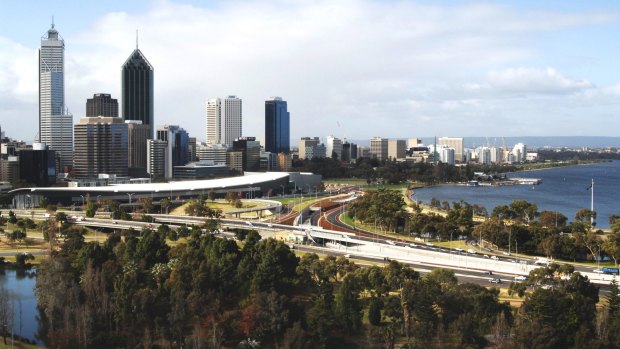By Tim Elliott
It's tempting to imagine the founding of Perth as a triumph of frontier heroics. Actually, it began as a real estate scam. James Stirling, a British naval officer, arrived in 1829, having lured English investors with promises of riverfront land and natural riches. What they found were sand dunes and marshland. After allotting himself the best bit, Stirling began running the place like a personal fiefdom, handing out jobs to his friends and slandering his critics. Then, after 10 years, he sold up and returned to England, never to be seen in Australia again.
"What's amazing is how many memorials there are to him here," says Perth local Ryan Zaknich. "Stirling Street, Stirling Gardens, Stirling this, Stirling that. You'd think they would have wanted to kill him, but apparently not."

View of Perth's CBD from Kings Park.Credit: Alf Sorbello
A former state planner, Zaknich runs a company called Two Feet and a Heartbeat, which offers personalised walking tours of Perth. Combining two of his loves – history and travel – Zaknich specialises in revealing Perth's lesser-known corners. These include King Street in Northbridge, a premier shopping precinct where the opium dens of the 1800s have given way to Prada and Gucci, and the Old Courthouse, where police would tether Aborigines to the colonnades before trial. Then there's Rottnest Island, 19 kilometres off the coast. Today it's an eco-friendly family resort; in the past it had a reputation as a party island and, before that, it was a prison for Indigenous men.
Perth has always been a place of swinging fortunes and convulsive change. Right now, it's crawling out of the crater left by the collapse of the most recent resource boom. "Before the bust, there were about six homeless people," says Zaknich. "After the bust, there were 300."
As a result, the city keeps having to reinvent itself, whether it be urban renewal – at one point, Zaknich walks me past a community centre that was a drug den 20 years ago – or the $73 million redevelopment of Yagan Square, in the city's centre. The old Treasury Buildings have also been repurposed and include a luxury hotel, Como The Treasury, which is doubtless hoping to see a slice of the traffic from Qantas's new non-stop route between Perth and London.
Historic Fremantle was once a stand-alone city that, over the decades, has merged with its larger neighbour. Locals talk of "heading to Freo" as if they're going to Darwin when, in fact, it's no more than a 30-minute drive from the Perth CBD. If you survive the arduous trek, make sure you stay a night or two, if only to take in the heritage-listed sandstone streetscapes and the statue of the original AC/DC lead singer, Bon Scott (his ashes are interred at Fremantle Cemetery). Perthites similarly call the Swan Valley a "region", despite it also being about a half-hour's drive away. Go there. Drink much wine.
When you do wend your way back, there's one last thing you have to see. It's a 750-year-old, 36-tonne, 14-metre-high tree called The Giant Boab in Kings Park, the botanical gardens which offer the best views over the Swan River and the city. The Giant Boab was originally growing in the Kimberley, in northern WA. In 2008, it had to be moved to make way for roadworks, so they trucked it 3200 kilometres south and surrounded it with 14 smaller boabs, to keep it company. Together, these trees share the best real estate in Perth. No doubt James Stirling would approve.
To read more from Good Weekend magazine, visit our page at The Sydney Morning Herald or The Age.